Chenghao Yang
DiscoX: Benchmarking Discourse-Level Translation task in Expert Domains
Nov 14, 2025Abstract:The evaluation of discourse-level translation in expert domains remains inadequate, despite its centrality to knowledge dissemination and cross-lingual scholarly communication. While these translations demand discourse-level coherence and strict terminological precision, current evaluation methods predominantly focus on segment-level accuracy and fluency. To address this limitation, we introduce DiscoX, a new benchmark for discourse-level and expert-level Chinese-English translation. It comprises 200 professionally-curated texts from 7 domains, with an average length exceeding 1700 tokens. To evaluate performance on DiscoX, we also develop Metric-S, a reference-free system that provides fine-grained automatic assessments across accuracy, fluency, and appropriateness. Metric-S demonstrates strong consistency with human judgments, significantly outperforming existing metrics. Our experiments reveal a remarkable performance gap: even the most advanced LLMs still trail human experts on these tasks. This finding validates the difficulty of DiscoX and underscores the challenges that remain in achieving professional-grade machine translation. The proposed benchmark and evaluation system provide a robust framework for more rigorous evaluation, facilitating future advancements in LLM-based translation.
Optimizing Diversity and Quality through Base-Aligned Model Collaboration
Nov 07, 2025Abstract:Alignment has greatly improved large language models (LLMs)' output quality at the cost of diversity, yielding highly similar outputs across generations. We propose Base-Aligned Model Collaboration (BACo), an inference-time token-level model collaboration framework that dynamically combines a base LLM with its aligned counterpart to optimize diversity and quality. Inspired by prior work (Fei et al., 2025), BACo employs routing strategies that determine, at each token, from which model to decode based on next-token prediction uncertainty and predicted contents' semantic role. Prior diversity-promoting methods, such as retraining, prompt engineering, and multi-sampling methods, improve diversity but often degrade quality or require costly decoding or post-training. In contrast, BACo achieves both high diversity and quality post hoc within a single pass, while offering strong controllability. We explore a family of routing strategies, across three open-ended generation tasks and 13 metrics covering diversity and quality, BACo consistently surpasses state-of-the-art inference-time baselines. With our best router, BACo achieves a 21.3% joint improvement in diversity and quality. Human evaluations also mirror these improvements. The results suggest that collaboration between base and aligned models can optimize and control diversity and quality.
FinSearchComp: Towards a Realistic, Expert-Level Evaluation of Financial Search and Reasoning
Sep 16, 2025



Abstract:Search has emerged as core infrastructure for LLM-based agents and is widely viewed as critical on the path toward more general intelligence. Finance is a particularly demanding proving ground: analysts routinely conduct complex, multi-step searches over time-sensitive, domain-specific data, making it ideal for assessing both search proficiency and knowledge-grounded reasoning. Yet no existing open financial datasets evaluate data searching capability of end-to-end agents, largely because constructing realistic, complicated tasks requires deep financial expertise and time-sensitive data is hard to evaluate. We present FinSearchComp, the first fully open-source agent benchmark for realistic, open-domain financial search and reasoning. FinSearchComp comprises three tasks -- Time-Sensitive Data Fetching, Simple Historical Lookup, and Complex Historical Investigation -- closely reproduce real-world financial analyst workflows. To ensure difficulty and reliability, we engage 70 professional financial experts for annotation and implement a rigorous multi-stage quality-assurance pipeline. The benchmark includes 635 questions spanning global and Greater China markets, and we evaluate 21 models (products) on it. Grok 4 (web) tops the global subset, approaching expert-level accuracy. DouBao (web) leads on the Greater China subset. Experimental analyses show that equipping agents with web search and financial plugins substantially improves results on FinSearchComp, and the country origin of models and tools impact performance significantly.By aligning with realistic analyst tasks and providing end-to-end evaluation, FinSearchComp offers a professional, high-difficulty testbed for complex financial search and reasoning.
Tokenized Bandit for LLM Decoding and Alignment
Jun 08, 2025



Abstract:We introduce the tokenized linear bandit (TLB) and multi-armed bandit (TMAB), variants of linear and stochastic multi-armed bandit problems inspired by LLM decoding and alignment. In these problems, at each round $t \in [T]$, a user submits a query (context), and the decision maker (DM) sequentially selects a token irrevocably from a token set. Once the sequence is complete, the DM observes a random utility from the user, whose expectation is presented by a sequence function mapping the chosen token sequence to a nonnegative real value that depends on the query. In both problems, we first show that learning is impossible without any structure on the sequence function. We introduce a natural assumption, diminishing distance with more commons (DDMC), and propose algorithms with regret $\tilde{O}(L\sqrt{T})$ and $\tilde{O}(L\sqrt{T^{2/3}})$ for TLB and TMAB, respectively. As a side product, we obtain an (almost) optimality of the greedy decoding for LLM decoding algorithm under DDMC, which justifies the unresaonable effectiveness of greedy decoding in several tasks. This also has an immediate application to decoding-time LLM alignment, when the misaligned utility can be represented as the frozen LLM's utility and a linearly realizable latent function. We finally validate our algorithm's performance empirically as well as verify our assumptions using synthetic and real-world datasets.
MARS-Bench: A Multi-turn Athletic Real-world Scenario Benchmark for Dialogue Evaluation
May 27, 2025Abstract:Large Language Models (\textbf{LLMs}), e.g. ChatGPT, have been widely adopted in real-world dialogue applications. However, LLMs' robustness, especially in handling long complex dialogue sessions, including frequent motivation transfer, sophisticated cross-turn dependency, is criticized all along. Nevertheless, no existing benchmarks can fully reflect these weaknesses. We present \textbf{MARS-Bench}, a \textbf{M}ulti-turn \textbf{A}thletic \textbf{R}eal-world \textbf{S}cenario Dialogue \textbf{Bench}mark, designed to remedy the gap. MARS-Bench is constructed from play-by-play text commentary so to feature realistic dialogues specifically designed to evaluate three critical aspects of multi-turn conversations: Ultra Multi-turn, Interactive Multi-turn, and Cross-turn Tasks. Extensive experiments on MARS-Bench also reveal that closed-source LLMs significantly outperform open-source alternatives, explicit reasoning significantly boosts LLMs' robustness on handling long complex dialogue sessions, and LLMs indeed face significant challenges when handling motivation transfer and sophisticated cross-turn dependency. Moreover, we provide mechanistic interpretability on how attention sinks due to special tokens lead to LLMs' performance degradation when handling long complex dialogue sessions based on attention visualization experiment in Qwen2.5-7B-Instruction.
Grounded Persuasive Language Generation for Automated Marketing
Feb 24, 2025



Abstract:This paper develops an agentic framework that employs large language models (LLMs) to automate the generation of persuasive and grounded marketing content, using real estate listing descriptions as our focal application domain. Our method is designed to align the generated content with user preferences while highlighting useful factual attributes. This agent consists of three key modules: (1) Grounding Module, mimicking expert human behavior to predict marketable features; (2) Personalization Module, aligning content with user preferences; (3) Marketing Module, ensuring factual accuracy and the inclusion of localized features. We conduct systematic human-subject experiments in the domain of real estate marketing, with a focus group of potential house buyers. The results demonstrate that marketing descriptions generated by our approach are preferred over those written by human experts by a clear margin. Our findings suggest a promising LLM-based agentic framework to automate large-scale targeted marketing while ensuring responsible generation using only facts.
CryptoX : Compositional Reasoning Evaluation of Large Language Models
Feb 08, 2025Abstract:The compositional reasoning capacity has long been regarded as critical to the generalization and intelligence emergence of large language models LLMs. However, despite numerous reasoning-related benchmarks, the compositional reasoning capacity of LLMs is rarely studied or quantified in the existing benchmarks. In this paper, we introduce CryptoX, an evaluation framework that, for the first time, combines existing benchmarks and cryptographic, to quantify the compositional reasoning capacity of LLMs. Building upon CryptoX, we construct CryptoBench, which integrates these principles into several benchmarks for systematic evaluation. We conduct detailed experiments on widely used open-source and closed-source LLMs using CryptoBench, revealing a huge gap between open-source and closed-source LLMs. We further conduct thorough mechanical interpretability experiments to reveal the inner mechanism of LLMs' compositional reasoning, involving subproblem decomposition, subproblem inference, and summarizing subproblem conclusions. Through analysis based on CryptoBench, we highlight the value of independently studying compositional reasoning and emphasize the need to enhance the compositional reasoning capabilities of LLMs.
Hello Again! LLM-powered Personalized Agent for Long-term Dialogue
Jun 09, 2024
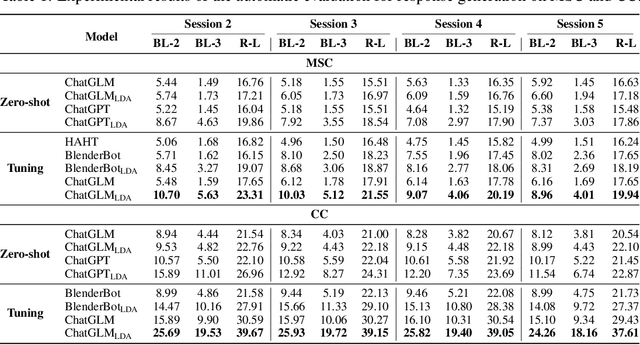
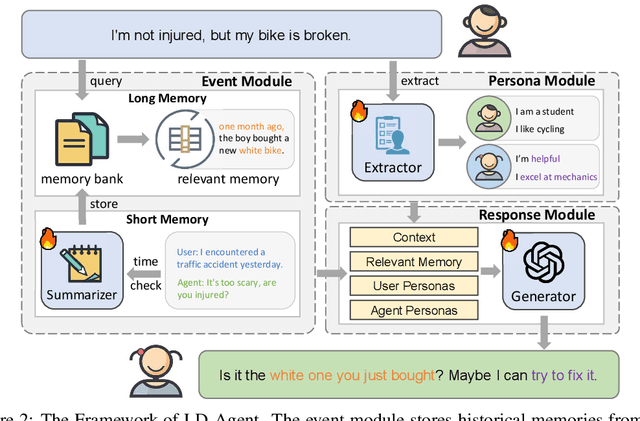

Abstract:Open-domain dialogue systems have seen remarkable advancements with the development of large language models (LLMs). Nonetheless, most existing dialogue systems predominantly focus on brief single-session interactions, neglecting the real-world demands for long-term companionship and personalized interactions with chatbots. Crucial to addressing this real-world need are event summary and persona management, which enable reasoning for appropriate long-term dialogue responses. Recent progress in the human-like cognitive and reasoning capabilities of LLMs suggests that LLM-based agents could significantly enhance automated perception, decision-making, and problem-solving. In response to this potential, we introduce a model-agnostic framework, the Long-term Dialogue Agent (LD-Agent), which incorporates three independently tunable modules dedicated to event perception, persona extraction, and response generation. For the event memory module, long and short-term memory banks are employed to separately focus on historical and ongoing sessions, while a topic-based retrieval mechanism is introduced to enhance the accuracy of memory retrieval. Furthermore, the persona module conducts dynamic persona modeling for both users and agents. The integration of retrieved memories and extracted personas is subsequently fed into the generator to induce appropriate responses. The effectiveness, generality, and cross-domain capabilities of LD-Agent are empirically demonstrated across various illustrative benchmarks, models, and tasks. The code is released at https://github.com/leolee99/LD-Agent.
Equipping Transformer with Random-Access Reading for Long-Context Understanding
May 21, 2024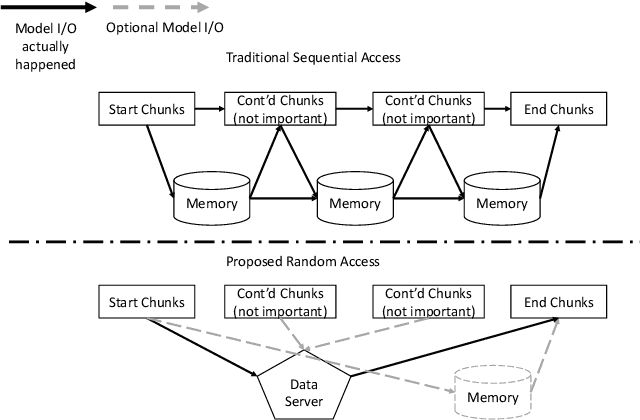

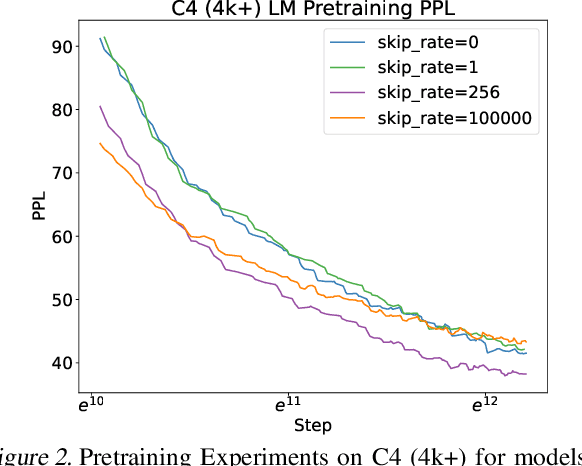
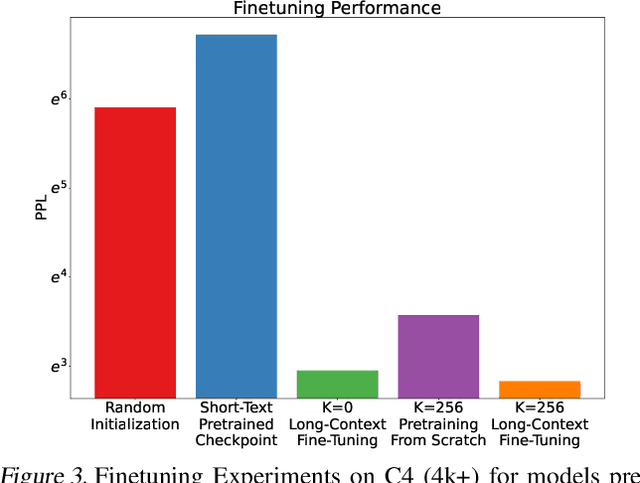
Abstract:Long-context modeling presents a significant challenge for transformer-based large language models (LLMs) due to the quadratic complexity of the self-attention mechanism and issues with length extrapolation caused by pretraining exclusively on short inputs. Existing methods address computational complexity through techniques such as text chunking, the kernel approach, and structured attention, and tackle length extrapolation problems through positional encoding, continued pretraining, and data engineering. These approaches typically require $\textbf{sequential access}$ to the document, necessitating reading from the first to the last token. We contend that for goal-oriented reading of long documents, such sequential access is not necessary, and a proficiently trained model can learn to omit hundreds of less pertinent tokens. Inspired by human reading behaviors and existing empirical observations, we propose $\textbf{random access}$, a novel reading strategy that enables transformers to efficiently process long documents without examining every token. Experimental results from pretraining, fine-tuning, and inference phases validate the efficacy of our method.
When Hindsight is Not 20/20: Testing Limits on Reflective Thinking in Large Language Models
Apr 14, 2024



Abstract:Recent studies suggest that self-reflective prompting can significantly enhance the reasoning capabilities of Large Language Models (LLMs). However, the use of external feedback as a stop criterion raises doubts about the true extent of LLMs' ability to emulate human-like self-reflection. In this paper, we set out to clarify these capabilities under a more stringent evaluation setting in which we disallow any kind of external feedback. Our findings under this setting show a split: while self-reflection enhances performance in TruthfulQA, it adversely affects results in HotpotQA. We conduct follow-up analyses to clarify the contributing factors in these patterns, and find that the influence of self-reflection is impacted both by reliability of accuracy in models' initial responses, and by overall question difficulty: specifically, self-reflection shows the most benefit when models are less likely to be correct initially, and when overall question difficulty is higher. We also find that self-reflection reduces tendency toward majority voting. Based on our findings, we propose guidelines for decisions on when to implement self-reflection. We release the codebase for reproducing our experiments at https://github.com/yanhong-lbh/LLM-SelfReflection-Eval.
 Add to Chrome
Add to Chrome Add to Firefox
Add to Firefox Add to Edge
Add to Edge